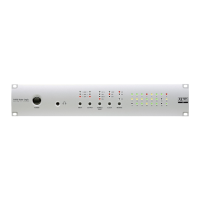3
I/O Capabilities
The number of channels available on each audio interface provided by the Alpha-Link is determined by the sample
rate and in certain circumstances by the mode of operation chosen.
Each unit can operate at one of four nominal sample rates; 44.1kHz, 48kHz, 88.2kHz and 96kHz. If locked to an
external clock source, each unit can also operate at a deviation of up to ±10% from these rates. Throughout this guide
we will often refer to the lower set of sample rates (44.1kHz, 48kHz) collectively as ‘Fs’ whilst the higher rates, being
twice the lower set, will be refered to as ‘2Fs’.
Early digital audio interfaces designed to run at 2Fs rates did so by modifying the way that data is packed into the
digital audio stream without increasing the actual transmission rate. This leads to a lower channel count for a given
interface but results in a 2Fs interface that is broadly compatible with the original Fs rate interface. Later improvements
for some interface types lead to ‘proper’ double speed 2Fs interfaces that did not compromise the channel count but
were no longer compatible with older Fs rate interfaces. These developments resulted in two different modes of
operation at the higher 2Fs rates; ‘Legacy’ or ‘SMUX’ and ‘High Speed’. The channel count differences are loosely
summarised in the following table and further information will be found towards the rear of this guide.
Audio Interface
Sample Rate and Mode
Fs 2Fs (Legacy/SMUX) 2Fs (High Speed)
ADAT 24 Channels 12 Channels n/a
AES/EBU 24 Channels 12 Channels 24 Channels
Analogue 24 Channels – irrespective of sample rate
Expansion Port 64 Channels – irrespective of sample rate
MADI 56 or 64 Channels 28 or 32 Channels 28 or 32 Channels

